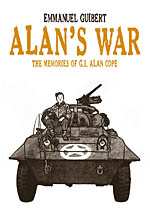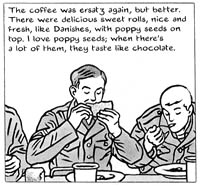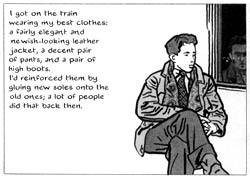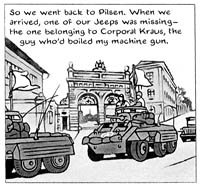 By Emmanuel Guibert
By Emmanuel Guibert
336 pages, black and white
Published by First Second Books
Have you ever read one of those books that you absolutely cannot put back down? That was absolutely the case for me when it came to Alan’s War: The Memories of G.I. Alan Cope. What was a strictly chance meeting—comic creator Emmanuel Guibert and World War II American soldier Alan Cope—spawned not only a long friendship, but the retelling of Cope’s experiences in the European theatre in the 1940s. As the last of the World War II veterans are vanishing, a book like Alan’s War in many ways is more important than ever, recording those memories with such great ability and power.
Cope’s story, as dictated to Guibert, doesn’t pull any punches right from the get go. It would certainly be easy for Cope to portray himself in a particularly great light, but instead Cope lays it all out on the table as he remembers it, admitting that he’d never even heard of Pearl Harbor when America was suddenly plunged into World War II. Leaping into the moment that Cope was drafted, Alan’s War tells the experience by leaving nothing out.  Training at Fort Knox is balanced with having to switch sleeping bunks on the train ride there, and care packages from his fellow soldiers’s families make as much of an impression as being in France and Germany. It’s by giving this full picture of what it was like for Cope to enter the war that you start to get an idea about what a huge, life-changing experience this became. Cope’s world was turned upside down after being drafted, and to only focus on the actual business of war would have left so much out of the experience.
Training at Fort Knox is balanced with having to switch sleeping bunks on the train ride there, and care packages from his fellow soldiers’s families make as much of an impression as being in France and Germany. It’s by giving this full picture of what it was like for Cope to enter the war that you start to get an idea about what a huge, life-changing experience this became. Cope’s world was turned upside down after being drafted, and to only focus on the actual business of war would have left so much out of the experience.
There are certainly a lot of pieces of Alan’s War that will probably surprise modern audiences. The entire first third of Alan’s War has to do with Cope’s training as a soldier—how to drive a tank, how to be a radio operator, how to shoot a rifle—rather than being in the war itself. But it’s not until the end of those stories that the reason for amount of material becomes obvious. While Cope was drafted when he turned 18, he doesn’t actually set foot in Europe until his 20th birthday. It’s pieces of information like that which help enrich and make Alan’s War an actual memoir instead of just a list of footnotes about an important time period. And, as said before, Cope and Guibert don’t leave less-savory details out of the book. Cope admits to having looted in a fit of frustration, and it’s an especially interesting admission because while he neither apologizes nor really tries to justify his actions, you still get a real sense of how he felt at the time as well as now about his actions, and it makes his character that much more interesting.
 The last third of Alan’s War is actually after the end of World War II, and that amount of extra material is absolutely justified. Through the rest of his life, you really see how being drafted ended up changing Cope’s future. The relationships that he formed with both people and with Europe carry through for the rest of his life, and it’s interesting to not only see how it set Cope down a very different series of paths than he expected, but how even once he’d settled down that faces from the past continued to resurface. I think a lesser writer would have cut this material out, or at the very least condensed it to a fraction of its length, but Guibert very wisely gives it the space it needs to really unfold. It’s a strong reminder of how a war’s conclusion does not mean that it’s erased from the lives of the participants, and how much of a lasting impact it really creates.
The last third of Alan’s War is actually after the end of World War II, and that amount of extra material is absolutely justified. Through the rest of his life, you really see how being drafted ended up changing Cope’s future. The relationships that he formed with both people and with Europe carry through for the rest of his life, and it’s interesting to not only see how it set Cope down a very different series of paths than he expected, but how even once he’d settled down that faces from the past continued to resurface. I think a lesser writer would have cut this material out, or at the very least condensed it to a fraction of its length, but Guibert very wisely gives it the space it needs to really unfold. It’s a strong reminder of how a war’s conclusion does not mean that it’s erased from the lives of the participants, and how much of a lasting impact it really creates.
Guibert’s art in Alan’s War is beautiful; as fantastic as his watercolor art in The Professor’s Daughter was, I think I actually like his creations here even more. Guibert uses a simple, thin line to delicately draw the faces of his characters, allowing a lot of white space to fill in the details in our imagination. Guibert is capable of so much expression and emotion with this style; you can see Cope’s indecision and naivety so clearly thanks to the art, telling the story with additional levels that words alone would never quite convey.  Guibert is just as good with the surroundings in Alan’s War; from small houses to large city streets, and marching battalions to rolling tanks, every scene comes across so vividly that it can’t help but make you feel like you’re there with Cope throughout his life. Guibert is careful in terms of how much detail he places into his art; many panels have empty backgrounds, to deliberately focus your attention on the people and events in the foreground, and it works very well. At the same time, though, he’s not afraid to add in the additional material when necessary; whatever is needed to tell the story is ultimately what Guibert draws.
Guibert is just as good with the surroundings in Alan’s War; from small houses to large city streets, and marching battalions to rolling tanks, every scene comes across so vividly that it can’t help but make you feel like you’re there with Cope throughout his life. Guibert is careful in terms of how much detail he places into his art; many panels have empty backgrounds, to deliberately focus your attention on the people and events in the foreground, and it works very well. At the same time, though, he’s not afraid to add in the additional material when necessary; whatever is needed to tell the story is ultimately what Guibert draws.
I’ve already read all of Alan’s War twice, and I suspect before the year is over I’ll have tackled it several additional times. Published in French as three volumes of La Guerre d’Alan, I’m delighted that First Second not only published Alan’s War but as one complete book. This is the sort of story that once you begin, you’ll not want to stop until you finish. Guibert has talked about creating a companion volume titled Alan’s Youth taking place in Cope’s earlier life, and if it’s half as interesting as Alan’s War it will be a winner. This is easily one of my favorite books published all year long, and I suspect if you read it you’ll feel the same way. Highly recommended.
Purchase Links: Amazon.com
